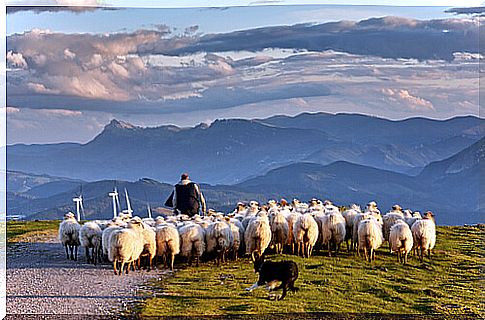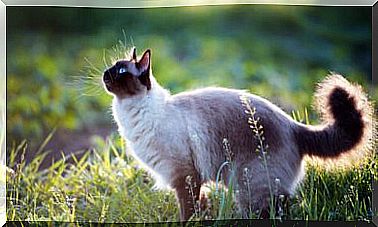Sheep: Feeding And Temperament

The sheep is an animal domesticated for more than 7,000 years by man. A sheep can provide wool, milk, meat and fat to a community. For this reason, the sheep has been highly valued by mankind due to its usefulness.
Sheep are shy animals with a gentle temperament. They prefer quiet and peaceful places to graze and chew. In general, sheep are social animals. This implies that they prefer to stay with the group, and will seldom wander off alone, so sheep that are found alone are lost sheep.
Sheep are very intelligent animals. Various studies have confirmed that a sheep can recognize up to 60 individual sheep, 5 dogs and at least 10 humans. Of course, like companion animals, sheep learn their names if you give them one and come when called.
The habitat of the sheep is quite varied, and it depends a lot on the breed of sheep. Among the areas that sheep can inhabit are the pasture plains, semi-desert areas, cold areas near the polar areas and areas not so polar but with high altitude.
In general, the most widespread characteristic in sheep’s habitat is its warm to cold temperature. This allows the wool to develop with more quality and thickness. However, a sheep will be happy in almost any weather as long as it is close to its flock.
The countries with the largest number of sheep are Australia, China, India, Iran and Nigeria, although they live almost all over the world. An average sheep lives between 10 and 12 years. However, under optimal health conditions, with a proper diet, enough exercise, and a stress-free environment, a sheep can live for more than 20 years.

Morphological characteristics and reproduction
In general, sheep are between one and two meters in length, and between half and a meter in height, depending on their breed. Specimens of the smallest sheep breeds can weigh 35 kilograms, while the largest sheep will weigh more than 100 kilograms.
Sheep hair is commonly known as wool and its market value depends on the quality of the hair and the species of sheep. The coat of sheep, in general, is light in color, although some breeds of sheep have dark hairs that are highly desired in the textile market.
Although their hearing and olfactory senses are quite acute, and they perceive elements at a long distance, sheep’s vision is quite limited. Due to the location of the eyes on the sheep’s face, these animals do not have good lateral visibility. This characteristic makes them vulnerable to predators.
Sheep have several periods of jealousy in a year. Once a sheep has been fertilized, gestation lasts about 150 days (approximately 5 months). Usually, as with humans, sheep have a single calf per gestation.
Feeding a sheep
Sheep are ruminant animals. This means that a sheep’s stomach is divided into four parts. When a sheep eats food, it goes to the first stomach. Soon after, the sheep regurgitates the food, chews it again, and it goes to the second stomach. This process is repeated four times.

For this reason, sheep usually feed early in the morning and late in the afternoon only. The rest of the time, the sheep spend it ruminating the food eaten.
Sheep are herbivorous animals. In a natural state, where the sheep can graze freely, it will feed on grasses, shrubs and legumes. In general, these animals are considered primarily grasses and consume grass in large quantities.
The feeding of a sheep will vary slightly according to the breed. Small breeds tend to eat more fiber than large breeds, although large breeds tend to feed on more diverse plants.
Either way, a sheep can consume an enormous amount of food in a short time. This is done to be able to digest what you consume slowly and parsimony.
Their eating habits determine the character and temperament of a sheep. In general, sheep are peaceful and calm animals that avoid shocks and adventures. They are very sociable and friendly animals when they have been treated properly by their keepers.









